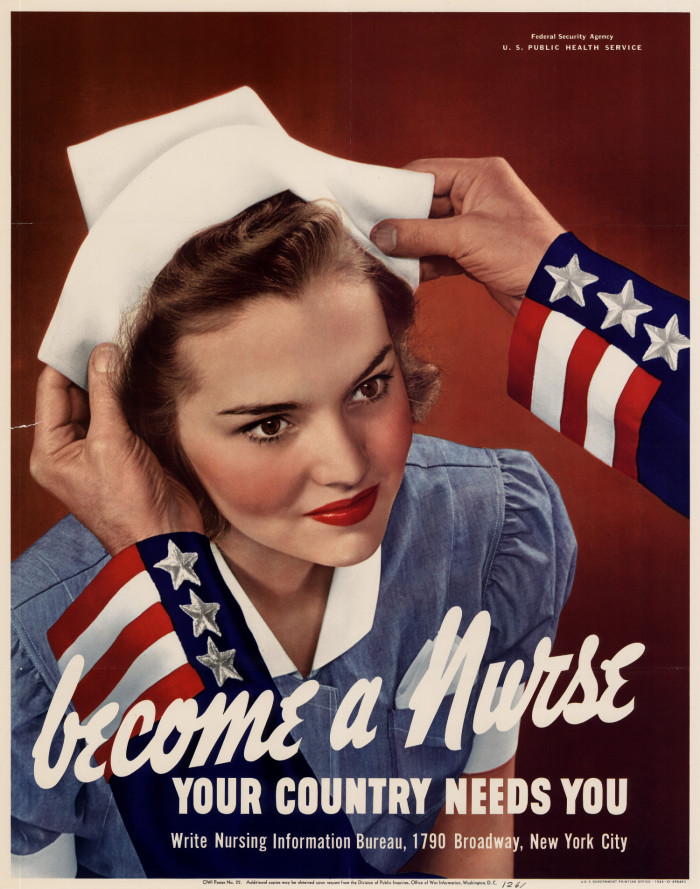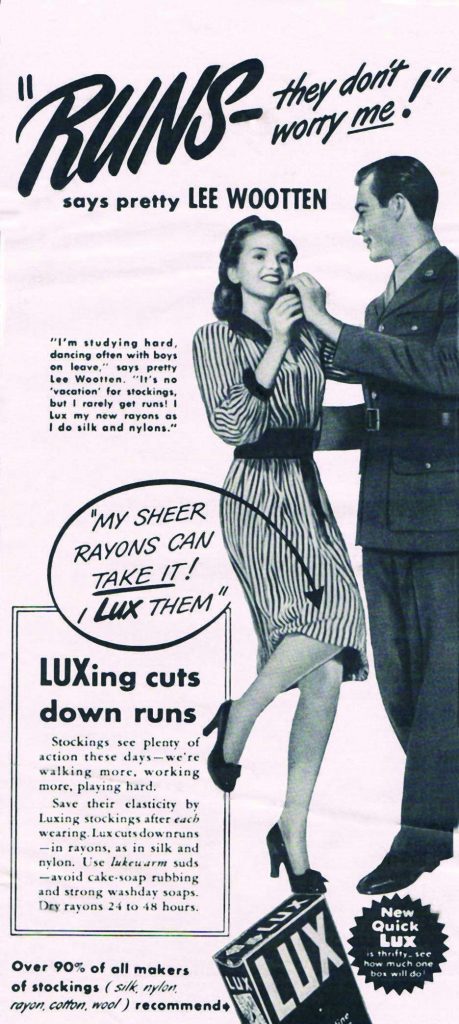
We are saddened to learn that Weslee Price D’Audney (née Wooten), the model for one of the most well-known and successful propaganda posters of World War II, has died.
Student and Model
During World War II, while still a teenager, Weslee Price Wootten was enrolled as a pre-med student at Columbia University’s Barnard College in New York City, paying for her education by modelling in back-to-school fashion shows for Fifth Avenue stores, by posing for magazine advertisements for products such as Jergen’s face cream and Lux soap, and by posing for story illustrations published in the Saturday Evening Post and the Ladies Home Journal. Good Housekeeping described her as the “clean face of young America.”

Weslee Wootten in an advertisement for Lux soap.
Meanwhile, in response to the urgent need for recruitment and training of nurses in both the military and the private sectors during the participation of the United States in World War II, the Bolton Act was passed unanimously by the U.S. Congress on on June 15, 1943 and signed by President Roosevelt on July 1. This act established the U.S. Cadet Nurse Corps and provided grants to nursing schools to pay for students’ tuition, fees, and other expenses, and provided a uniform. In return, students pledged to finish their education within 30 months and to engage in “military or essential civilian nursing throughout the war.” A massive advertising campaign was implemented to attract young women to the program. Because a non-discrimination clause was included in the statute, the program provided African-American, Japanese-American, and Native American women an unprecedented opportunity not only to serve their country in wartime, but also to acquire valuable skills, experience, and respect that would benefit them after the war.
While the details of this program were still being worked out, Weslee received a call from WIlliam Ritter, a prominent advertising photographer with whom she had worked before. When she arrived at his office, he provided her with a student nurse’s uniform. An older man was also present, and he was provided with a pair of detached navy-blue sleeves decorated with white stars and red, white, and blue stripes.
In contrast to his usual practice of trying out multiple compositions and poses, this time Ritter instructed everyone to follow a single layout that had been drawn up prior to the photography session. It depicted a pair of arms reaching out to place a nurse’s cap on the head of the young nurse, whose face was blank in the pencil-drawn design.
“This one is important—it is big,” the photographer intoned portentously. The government-approved layout had been provided by the J. Walter Thompson advertising agency and was to be followed precisely. In a letter Weslee wrote to the UNT Libraries decades later, she explained the symbolism, which was perhaps not as clear to 21st century audiences as it was to wartime viewers:
At the time the man was called Uncle Sam and I am sure that in 1942 everyone understood that it was Uncle Sam (the US Government) funding the new Cadet Nurse program.
The photo was printed on a poster with the caption “Become a Nurse—Your Country Needs You,” followed by instructions to write to the Nursing Information Bureau for more information about the Cadet Nurse Corps. At least a million copies of the poster were printed and distributed throughout the United States in doctors’ offices, post offices, libraries, schools, and other public buildings. Every day Weslee would pass by her image hanging in the hallways, cafeterias, and dormitories of Barnard. At the end of the semester she asked the dean if she might take one home, and she was given two. One she gave to her mother, and the other she kept for herself until the end of her life.
Wife and Mother
Before the war ended, Weslee Wootten’s own nursing career was unexpectedly sidelined when she was volunteering as a hostess at a servicemen’s canteen in New York and met Flight Lieutenant Wallace Noel D’Audney of the Royal New Zealand Air Force on his third day of leave. After only seven days of courtship, he said he wanted to marry her. For the next two and a half years, they wrote letters to each other while he fought in the African and Italian campaigns and she volunteered at the Anzac Club in New York, where she led groups of Anzacs on sightseeing tours of New York City.
At the end of the war Noel would have been sent back to New Zealand if he remained unmarried, so Weslee sent a telegram to the War Ministry in London saying she planned to marry him when he arrived back in New York. According to Weslee he was given what was called “compassionate leave,” but his buddies referred to it as “passionate leave.” They were married on July 1, 1945; then, two weeks after their honeymoon in the Poconos, Noel had to return to New Zealand. In November Weslee joined her husband via the first ship available carrying civilians to New Zealand.
In 1947, after their first child was born, the couple moved to Palo Alto, California in search of a better job market than what was available in New Zealand. Soon after they moved to San Francisco, then New Jersey, and eventually to Portland, Oregon. At every new location they added a new child to their family until they had a total of five. Everywhere they lived, they found room for Weslee’s poster.
Educator and Writer
Starting and raising a family may have ended one career, but it also started another.
Weslee’s youngest child, Bruce, was born with multiple disabilities. His eighth cranial nerve, which controls hearing and balance, was not functioning. He was profoundly deaf and intellectually disabled, although he was able to engage with the world and the people in it, and he also had mild cerebral palsy and vision problems. In 1968, when she couldn’t find adequate care for him, she went back to university at the age of 44 to learn how to teach profoundly deaf and multi-handicapped children. There was no mainstream education available for children with multiple disabilities, but she was able to teach her son at home. Eventually she earned a Master of Science in Special Education and a Specialist in Education degree in Educational Administration and had a successful career as a teacher of the deaf, a university professor, and an administrator.
The D’Audneys had moved to Nebraska, and Weslee served as associate professor at the University of Nebraska Medical Center and as project director for two federally-funded programs for the early identification and education of handicapped children.
In addition to her teaching and administrative work, Weslee published books and articles on the care of disabled children. In the 1970s she edited and co-wrote Giving a Head Start to Parents of the Handicapped, a manual containing information for personnel of the Head Start program on how to provide encouragement and support to parents of handicapped children.
Return to Celebrity
In the mid-1970s Weslee and Noel retired and moved back to New Zealand, where they purchased a clifftop home overlooking Red Beach, north of Auckland. Here Weslee wrote her memoirs, and after Noel passed away in 2001, she lived another three decades and eventually moved to Hibiscus Coast Retirement Village in Red Beach.
Weslee D’Audney’s image has remained well-known from its first printing to the present, but the model herself was anonymous for most of the time the poster existed, and when we first added the poster to our Digital Library‘s World War Poster collection, we too considered the model to be unknown until Weslee D’Audney herself wrote us a letter to enlighten us on the matter and alerted us to some accounts of her life that have been appearing in print and online since around 2008. Since then, she has been interviewed and profiled in several print and online publications.
Weslee had a wry appreciation for the irony of her situation:
I HAVE NEVER BEEN FAMOUS, though my face adorns a famous poster that blanketed America during World War II – and even now pops up almost weekly in a new form. I’m probably the only person alive who remembers its creation.
Although her appearance on this famous poster afforded Weslee a certain degree of celebrity, especially after her identity was revealed, and although she kept her copy of the poster to the end of her life and ultimately collected several more related items—the image has been reprinted on postcards, T-shirts, refrigerator magnets, even on an Israeli postage stamp—she always considered this experience to be relatively unimportant compared to her later achievements of raising a family, teaching, writing, and working with special needs children. Still, she was grateful that after over sixty years of anonymity the photographer and model could finally be credited. (The model who played Uncle Sam remains anonymous.)
On October 31, 2023, Weslee Wootten D’Audney passed away at the age of 98 years.
References
D’Audney, Weslee. “Patriotic Inspiration: The Tale behind a Wartime Image.” Signals, no. 106 (Jun 3, 2014): 18–21. https://issuu.com/anmmuseum/docs/signals_106
D’Audney, Weslee, editor. Giving a Head Start to Parents of the Handicapped. Omaha: Resource Center for Handicapped Children, Meyer Children’s Rehabilitation Institute, University of Nebraska Medical Center, 1976. https://files.eric.ed.gov/fulltext/ED119434.pdf
Frances Payne Bolton School of Nursing. “The Bolton Act: Making the Nursing Profession More Accessible to Everyone.” Case Western Reserve University. https://case.edu/nursing/about/history/bolton-act
Guthrie, Fleur. “War Time Model.” Australian Women’s Weekly, New Zealand edition. June 2013. https://www.pressreader.com/new-zealand/new-zealand-womans-weekly/20210503/281612423261513
Knight, Kim. “The Face behind a Famous Poster.” Sunday Star Times [New Zealand]. May 4, 2008. https://rnzaf.proboards.com/thread/5882/face-famous-poster
National Museum of American History. “Memories of a War Time Poster Model.” Smithsonian Institution. October 12, 2010. https://americanhistory.si.edu/explore/stories/memories-wartime-poster-model
U.S. Public Health Service. The United States Cadet Nurse Corps and Other Federal Training Programs. Washington, DC: Government Printing Office, 1950. PHS Publication No. 38. https://archive.org/details/CadetNurseCorps1943-1948/page/n5/mode/1up
“Wesley D’Audney Obituary.” New Zealand Herald. November 11, 2023. https://notices.nzherald.co.nz/nz/obituaries/nzherald-nz/name/weslee-d-audney-obituary?id=53559990
“Weslee Wootten Wed: Becomes Bride of Flight Lieut. W.N. D’Audney of New Zealand.” New York Times. July 2, 1945.
Article by Bobby Griffith.


Lou
Your blog took me back to cold snow season
before , during and after 2000. On one of those days I wanted to hear Cathy Hartman speak, but couldn’t due to the snow. As it turned out Cathy was snowed in also.
Twenty three years have lapsed since that day .
What lovely UNT memories I have.
AR allen
Hey, I am just amazed by seeing those images matching your topics by the way, it is a very informative article.